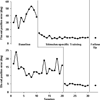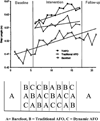Small sample research designs for evidence-based rehabilitation: issues and methods
- PMID: 22580169
- PMCID: PMC3413737
- DOI: 10.1016/j.apmr.2011.12.017
Small sample research designs for evidence-based rehabilitation: issues and methods
Abstract
Conventional research methods, including randomized controlled trials, are powerful techniques for determining the efficacy of interventions. These designs, however, have practical limitations when applied to many rehabilitation settings and research questions. Alternative methods are available that can supplement findings from traditional research designs and improve our ability to evaluate the effectiveness of treatments for individual patients. The focus on individual patients is an important element of evidenced-based rehabilitation. This article examines one such alternate approach: small-N research designs. Small-N designs usually focus on 10 or fewer participants whose behavior (outcomes) are measured repeatedly and compared over time. The advantages and limitations of various small-N designs are described and illustrated using 3 examples from the rehabilitation literature. The challenges and opportunities of applying small-N designs to enhance evidence-based rehabilitation are discussed.
Copyright © 2012 American Congress of Rehabilitation Medicine. Published by Elsevier Inc. All rights reserved.
Conflict of interest statement
Figures



References
-
- Law MC, MacDermid J. Evidence-based Rehabilitation: A Guide to Practice, 2nd Ed. Thorofare, NJ: Slack; 2008.
-
- Grimmer K, Bialocerkowski A, Kumar S, Milanese S. Implementing evidence in clinical practice: the 'therapies' dilemma. Physiotherapy. 2004;90(4):189–194.
-
- Bloom M, Fischer J, Orme JG. Evaluating Practice: Guidelines for the Accountable Professional. 6th Edition ed. Boston: Allyn and Bacon; 2009.
-
- Guyatt GH, Haynes RB, Jaeschke RZ, Cook DJ, Green L, Naylor CD, Wilson MC, Richardson WS. Users' Guides to the Medical Literature: XXV. Evidence-based medicine: principles for applying the Users' Guides to patient care. Evidence-Based Medicine Working Group. JAMA. 2000;284(10):1290–1296. - PubMed
Publication types
MeSH terms
Grants and funding
LinkOut - more resources
Full Text Sources
Medical

